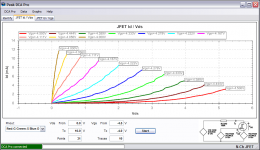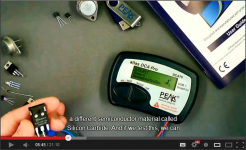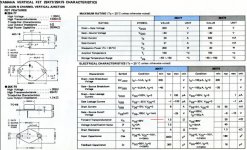Kudos to Jeremy Siddons of Peak Instruments UK for extending the Atlas 75 firmware flash for Sic depletion. He had an auto new software reminder the other day, but with a bug for depletion Mosfets like DN2540 that we reported back. He fixed it in no time. When we mentioned that the device knows nothing of Sic depletion Jfet he asked for the reverse and forward PN junction graphs. Now a new update bell rang and what do you know, it recognized and traced the R085! Traced it in the very confined limits of mA and few volts it can of course, but it gives Vgs(off) for 1uA and Vgs(on) for 5mA. Basic matching for Vgs in other words. Interesting how it shows like a small triode valve in the wee region of the traces though. Don't mind the wobbles, its the software driven CVS play and the Semisouth Sic reacting. If two samples trace close in this small signal area will they usually match higher too? Don't know, but I have seen it in power BJTs as a good probability, when the fully traced matches on a Tek matched with the same samples on the Peak.
Attachments
Very nice variation and also great for my headphone use ( similarly to l'amp with 30V supply)
Actually the unobtainium Yamaha sits are slightly better, according to Nelson's article in Linear Audio.
Oh, salas, I have the same Peak tester/tracer: does it recognize the sony k82?
I tested mines with other tools and I have a pair that were really close and would like to trace Em with the Peak (this weekend hopefully)
I would expect the custom PapaFET to be the best tweaked one for audio.
Actually the unobtainium Yamaha sits are slightly better, according to Nelson's article in Linear Audio.
Oh, salas, I have the same Peak tester/tracer: does it recognize the sony k82?
I tested mines with other tools and I have a pair that were really close and would like to trace Em with the Peak (this weekend hopefully)
Last edited:
That K77 has the most flat 45 degrees going curves indeed.
It should do K82 with firmware 9 because it did so with the R085. Just download the latest software from their website. It will reprogram the unit and update the PC. If it does not, email them. They are happy to try cover weird semis.
It should do K82 with firmware 9 because it did so with the R085. Just download the latest software from their website. It will reprogram the unit and update the PC. If it does not, email them. They are happy to try cover weird semis.
That K77 has the most flat 45 degrees going curves indeed.
About double transconductance of a sit1, iirc.
Yep main reason I bought the dcp75 instead of the basic model was that it measured jfets
Hi bonzo15011978,
It is OK to use X-over inductors in the appropriate sizes, preferably air-cored and wound with thicker than 16 awg copper wire.
Thank you very much audiong, can you give me some example?
I think this is no good,
INDUTTANZA A FILO AD ANELLO - 1,5mH; 3A; 45m? | eBay
but this should be fine (biggest one has 1.3mm coil diameter, I couldn't find bigger coils...)
AZ AUDIOCOMP BA 150 INDUTTANZA DA 1,5 mH LINEA BEST NUOVA | eBay
Speaking about the preamp, do you suggest the same preamp suitable to drive an F4 or a preamp with a 3x gain would do fine in a small room with 96db speakers?
Thank you again!
Hi bonzo15011978,
Unable to open the links you provided - so cannot comment.
A preamp able to drive the F4 should be adequate to drive both the 193V and follower versions of the 2SK82. Because it does not have any voltage gain , drive requirements for the follower version are more exacting. Depending on the output of your source components, the recorded level of your media and your preferred listing volume, the 3X preamp gain you mentioned might just be adequate for the follower version but will most certainly be enough for the 193V sersion.
Unable to open the links you provided - so cannot comment.
A preamp able to drive the F4 should be adequate to drive both the 193V and follower versions of the 2SK82. Because it does not have any voltage gain , drive requirements for the follower version are more exacting. Depending on the output of your source components, the recorded level of your media and your preferred listing volume, the 3X preamp gain you mentioned might just be adequate for the follower version but will most certainly be enough for the 193V sersion.
Thank you for your answer.
I couldn't fix the links, so I'll go straight to the point: 16AWG is the minimum required or is inadequate anyway?
Another question: your chassis is really beautiful (from an Engineer's point of view ;-) ), it seems made by small modules bolted togheter. Did you drill and bend them by yourself or I can buy the set somewhere?
Thank you again for your help!
I couldn't fix the links, so I'll go straight to the point: 16AWG is the minimum required or is inadequate anyway?
Another question: your chassis is really beautiful (from an Engineer's point of view ;-) ), it seems made by small modules bolted togheter. Did you drill and bend them by yourself or I can buy the set somewhere?
Thank you again for your help!
Hi bonzo15011978,
16AWG is fine for smaller inductor values. To avoid excessive DC resistance, use thicker gauge wire for values > 1mH.
I used Wakefield 423A (To-3 machined) and 423K (plain) heatsinks. The front panel is standard 5U and the rest of the chassis was assembled from pieces of flanged aluminum pieces and angle stock I happened to have on hand.
16AWG is fine for smaller inductor values. To avoid excessive DC resistance, use thicker gauge wire for values > 1mH.
I used Wakefield 423A (To-3 machined) and 423K (plain) heatsinks. The front panel is standard 5U and the rest of the chassis was assembled from pieces of flanged aluminum pieces and angle stock I happened to have on hand.
Hi audiong,
still searching for some free time to build something, but now I think I am settled with the power-buffer variation, so a pair of questions for you (thank you in advice for your time!):
Thank you so much!
still searching for some free time to build something, but now I think I am settled with the power-buffer variation, so a pair of questions for you (thank you in advice for your time!):
- Which is the input impedance? Or better, which is the output impedance needed for a preamp to drive the amp?
- What the pot is for? There is something I must set befor switching the amp on?
Thank you so much!
- Status
- This old topic is closed. If you want to reopen this topic, contact a moderator using the "Report Post" button.
- Home
- Amplifiers
- Pass Labs
- SIT Variations



